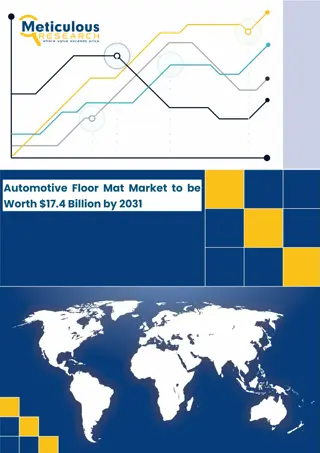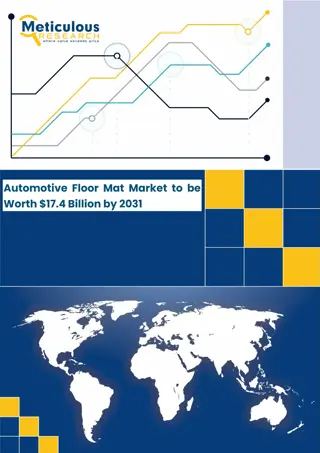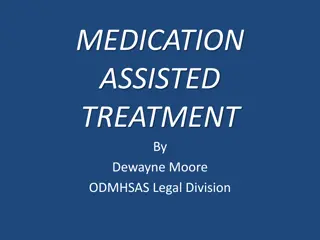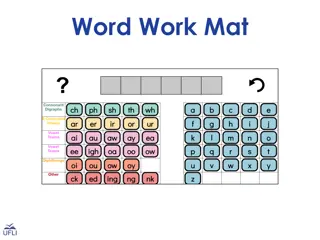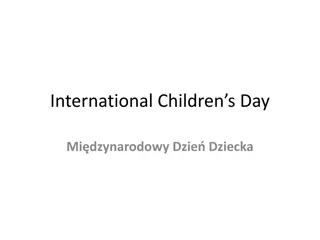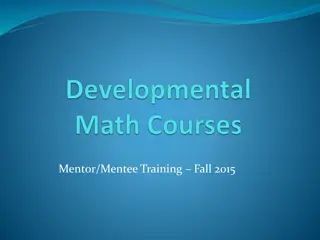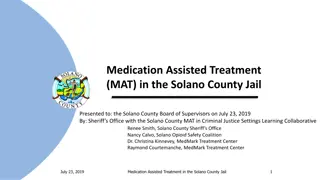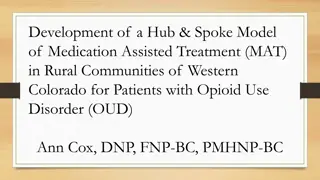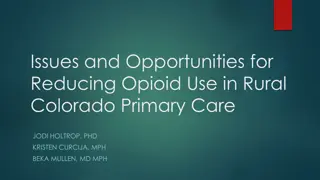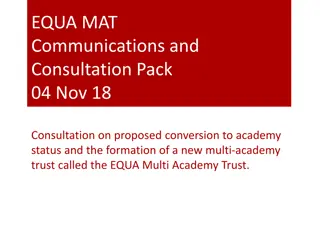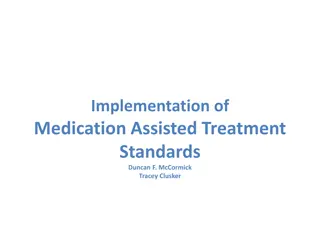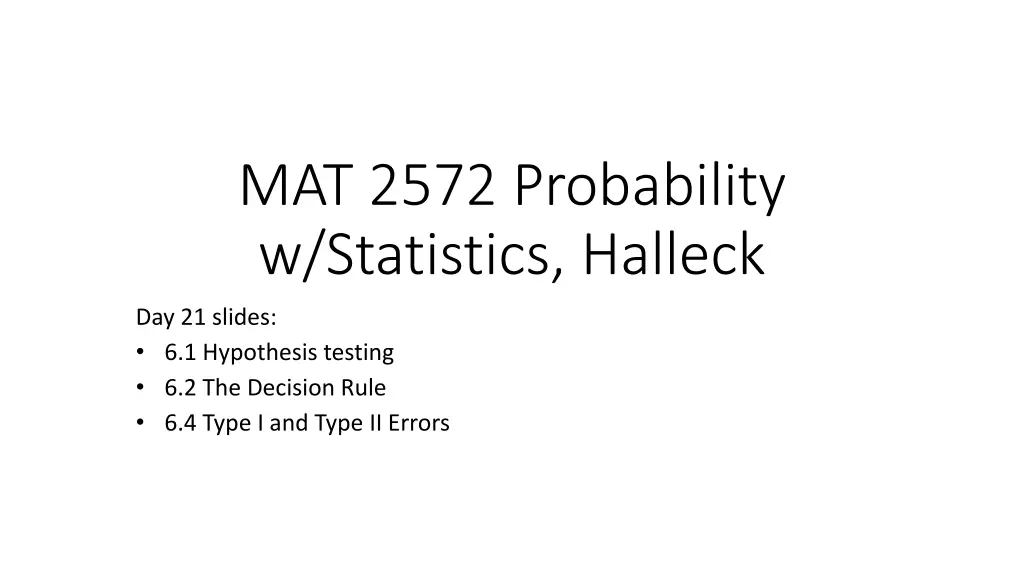
Understanding Hypothesis Testing: Key Concepts and Applications
Learn about hypothesis testing in statistics, where conclusions are drawn between conflicting theories based on data. Explore examples of dichotomy, the analogy of a court trial, and the rejection region approach. Understand how to choose between null and alternative hypotheses using test statistics and critical values.
Uploaded on | 0 Views
Download Presentation

Please find below an Image/Link to download the presentation.
The content on the website is provided AS IS for your information and personal use only. It may not be sold, licensed, or shared on other websites without obtaining consent from the author. If you encounter any issues during the download, it is possible that the publisher has removed the file from their server.
You are allowed to download the files provided on this website for personal or commercial use, subject to the condition that they are used lawfully. All files are the property of their respective owners.
The content on the website is provided AS IS for your information and personal use only. It may not be sold, licensed, or shared on other websites without obtaining consent from the author.
E N D
Presentation Transcript
MAT 2572 Probability w/Statistics, Halleck Day 21 slides: 6.1 Hypothesis testing 6.2 The Decision Rule 6.4 Type I and Type II Errors
6.1 Hypothesis testing Drawn from data, an inference is a conclusion, often about the underlying population So far our inferences have been numerical estimates of parameters, especially in the form of confidence intervals. However, in many situations, the conclusion to be drawn is not numerical but is a choice between two conflicting theories, or hypotheses.
Examples of dichotomy Psychiatrist pronounces an accused murderer sane or insane ; FDA decides whether new flu vaccine is effective or ineffective ; Geneticist concludes that the inheritance of eye color does or does not follow classical Mendelian principles. Exercise: come up with 2 of your own examples.
What is hypothesis testing in a nutshell? 1. Dichotomizing possible conclusions of an experiment 2. Using probability to choose one option over the other
Analogy of a court trial The two competing propositions are H0: the null hypothesis H1: the alternative hypothesis We assume the truth of H0. To reject H0 and accept H1 we must have strong evidence that H0 is false. Our choosing between H0and H1is similar to way a jury deliberates : defendant is presumed innocent unless data argue overwhelmingly to contrary.
Hypothesis Testing: rejection region rejection region approach Any function of observed data whose numerical value dictates whether H0 is accepted or rejected is a test statistic (TS). Values for the TS that result in rejection of H0 is the rejection region (RR). Values for TS that result in acceptance of H0 is acceptanceregion (AR). Point(s) that separate(s) RR from AR is (are) the critical value(s) (CV). Probability that TS lies in RR when H0is true is the significance level typically 1, 5 or 10% NOTES: The lower the , the stronger the evidence needed to reject H0. If is not explicitly given, assume that it is 5%.
Rejection Region Approach (cont.) Treatments are different depending on whether RR is one-tailed or two-tailed (tail(s) gel(s) with H1). Examples: One-tailed: The FDA has received complaints from consumers that the amount of cocoa is less than the 8 oz claimed on the box. To investigate, the FDA purchases a random sampling of 20 boxes and finds that the average amount in the boxes is 7.93 oz. If the standard deviation is .25 oz, does the FDA have enough evidence to conclude that the manufacturer is indeed cheating the consumer? Two-tailed: Joan s 15 measurements of the distance to a star average 542 light years (LY), which differs from the published distance of 534 LY. If the standard deviation is 10 LY, does Joan have enough evidence to reject the accepted distance?
Rejection Region: one-tailed (cocoa) example H0=8; H1< 8 (so tail is on left). TS is 7.93 and n=20. Standard error: ?= Critical value (CV): ? ?.95+ 8 = 0.056 1.64 + 8 = 7.91 Draw diagram and label rejection region (RR). Reject H0 iff (if and only if) TS falls within RR. ?=.25 20= 0.056
Rejection Region: one-tailed example (cont.) TS=7.93>7.91=CV TS does NOT fall within RR we do NOT reject H0. Thus, we do NOT have enough evidence to say cocoa company is cheating consumer. Rejection region z.95 = 1.65 7.91 1.65 ? 7.93 =TS 8 CV
Rejection Region: two-tailed example Two-tailed: Joan s 15 measurements of the distance to a star average 542 light years (LY), which differs from the published distance of 534 LY. If the standard deviation is 10 LY, does Joan have enough evidence to reject the accepted distance? H0=534; H1 534 (two-tailed). TS is 545 and n=15. Standard error: ?= Critical vals (CVs): ? ?.025+ = 2.58 1.96 + 534 = {529,539} Draw diagram label rejection region (RR). Reject H0 iff TS falls within RR. ?=10 15= 2.58
Rejection Region: two-tailed example (cont.) Rejection region TS=542>539=CV TS IS within RR we DO reject H0. Thus, Joan rejects the published/accepted value of the star s distance. z.025=1.96 529 534 1.96 ? CVs 539 542 =TS
Hypothesis Testing: p p- -value value approach 1. As with the critical region approach, calculate the test statistic (T.S.). 2. The p-value of an observed test statistic is the probability of getting a value for that test statistic as extreme as or more extreme than what was actually observed (assuming H0to be true). 3. Reject H0 iff the p-value is less than the significance level . How strength of evidence (p-value) and significance level ( ) are related: The strength of evidence needed to reject H0 is inversely related to . The lower the p-value, the stronger your evidence.
p p- -value value Approach (cont.) Treatments are again different depending on whether rejection region is one- or two-tailed: One-tailed: pet food always specifies a maximum moisture content. Pets-R-Us store brand says it s dry food has an 11% max moisture content. 9 samples are taken and average 11.5%. If = 1%, can we say that the moisture content of Pets-R-Us food is too high? Two-tailed: the mercury content of fish was measured 5 years ago at .11 ppm. If today, 25 fish are caught and the mercury content averages .10ppm with = .02, can we say that the mercury levels have changed?
p-value: one-tailed example H0=11; H1>11 (so tail is on right). TS is 11.5 and n=9. Standard error: ?= z =?? ? 1/3 Draw diagram, label TS, z and p-value (a region). Reject H0 iff p-value < (which we assume to be 5%). ?=1 9=1 3 =11.5 11 =1.5 so P-value is .067.
p-value: one-tailed example (cont.) Since p-value = .067 is NOT <.05= , we do not reject H0 . We can NOT say that the moisture content of Pets-R-Us food is too high p-value = .067 1.5 11.5 TS 10.3 10.7 11 11.3 11.7
p-value: two-tailed example The mercury content of fish was measured 5 years ago at .11 ppm. If today, 25 fish are caught and the mercury content averages .10 ppm with = .02, can we say that the mercury levels have changed? H0=.11; H1 .11 (so 2-tailed). TS is .10 and n=25. Standard error: ?= z =?? ? Draw diagram, label TS, z and p-value (a region). Reject H0 iff p-value < (which we assume to be 5%). ?=.02 25= .004 =.10 .11 .004= 2.5 so p-value is 2*P(z<-2.5)=2*.006=.012
p-value: two-tailed example (cont.) Since p-value = .012 <.05= , we DO reject H0 . In other words, the mercury content of the fish has changed. p-value = .012 (.06 in each tail) -2.5 .100 .102 TS .106 .11 .114 .118
Exercise: Create your own one- and two-tailed examples. Exchange problems with your neighbor. Solve ex 1 using rejection region and ex 2 using p-value approaches.
Type I and Type II Errors True State of Nature H0 is true H1 is true Our DecisionFail to reject H0 Correct decision Type II error Reject H0 Type I error Correct decision Court-of-law analogy: type I error = convict an innocent is considered worse than type II error = not convict a guilty
Chance of type I error Coincides precisely with significance level . For a criminal case, you want it to be low (perhaps =1%). For a civil case, can be a higher (perhaps =5 or 10%).
=Chance of type II error We introduce a new parameter and a new picture. On the same set of axes as the curve around the hypothesized mean, we create a normal curve around the actual mean. corresponds to being within the 2nd curve but not in Rejection Region The power = 1 represents ability to recognize H0 is false. We look at 2 situations: where the means are close where they are far apart
=Chance of type II error, case actual and hypothesized means are close is relatively high power 1 (chance to recognize that H0 is false) is relatively low
=Chance of type II error case actual and hypothesized means far apart is relatively low power 1 (chance to recognize that H0 is false) is relatively high
How to think of b In reality, you never know what the actual mean is, so b is only important from a theoretical point of view. In a sense, you are playing God, i.e., pretending to know things that no mortal person knows.
Exercise 6.2.2 An herbalist suspects his extracts affect IQ scores of students with ADD. 22 children take doses for two months. Children with ADD typically score an average of 95 on the IQ test with a standard deviation of 15. Let H0 be the assumption that the extracts have no affect on the scores. If =0.06, what values of ? would cause H0 to be rejected? Assume H1 is 2-sided. Standard error: ?= ?=15 22= 3.2 z.03 = 1.88, so CVs: ? ?.03 = 95 3.20 1.88 = {89.0,101.0} Reject if ? < 89 or > 101 88.6 91.8 95 98.2 101.4
Exercise 6.2.2 (cont.) & 6.4.3 An herbalist suspects his extracts affect IQ scores of students with ADD. 22 children take doses for two months. Children with ADD average 95 on IQ test with = 15. Let = 0.06. If the extracts do have an effect and that is, to lower the average score to 90, calculate the power of the test. Steps for solution: 1. Find 3 percentile value for curve 1 around 95: ? ?.97+ 95 = 89 2. Normalize this using the curve 2 around 90: z =? ?=89 90 = .31 3.2 3. Find the chance of being to its right in curve 2. = P(z > .31) = .62 4. Subtract from 1 to get the power: 1 = 1 .62 = .38 Note: for , technically, we should subtract off chance of being in the right tail of curve 1, but it will be relatively negligible (as can be seen from pic).
= Area under blue curve to right of red line = .62 Power = 1 = Area under blue curve to left of red line = .38 Hypothesized distribution: brown curve Actual distribution: blue curve
Summary of and power Assuming the H0 to be false and given the actual distribution: (the chance of a type II error) is the chance of falling within accepted region of hypothesized distribution. 1 represents the power of a test, namely its ability to reject H0 when it is false. The farther apart the actual and hypothesized means (relative to the standard error), the higher the power.




